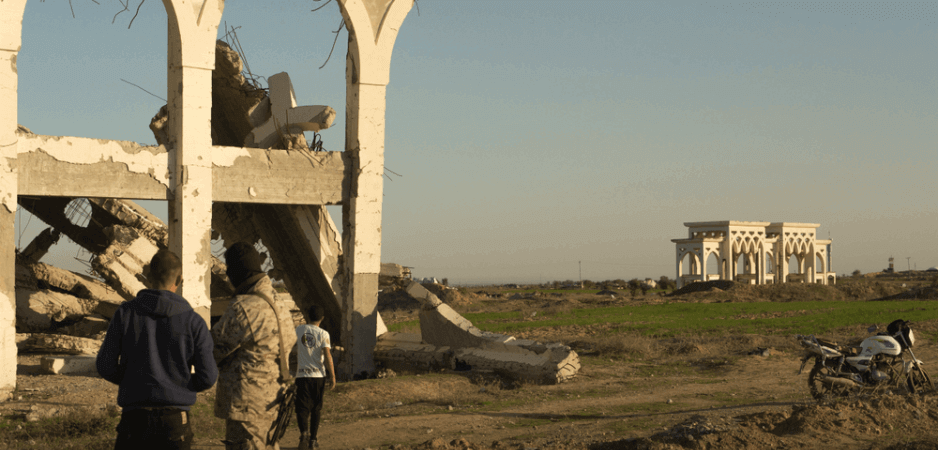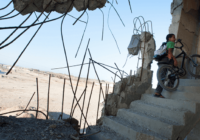While the world is paying more attention to Gaza, the intra-Palestinian divide is worsening the humanitarian crisis in the Strip.
Two major developments that recently took place in the Gaza Strip are shaping the current situation and future of the coastal enclave. The first development was the attack on the convoy of Palestinian Prime Minister Rami Ramallah on March 13, 2018. The second one is the Great March of Return, which started on March 30, and the violence that followed the protests. The first has put the reconciliation between the main Palestinian factions, Hamas and Fatah, on hold, whereas the second has disrupted the fragile calm that has existed between Hamas and Israel.
The mass protests that took place for several weeks at the Gaza border with Israel succeeded in bringing the humanitarian crises in the coastal enclave to the attention of the international media. It reminded the world, the European Union, the United States, Israel, and the Arab nations in particular, that the situation in Gaza is not stable despite the fact that it was long perceived as such.
Meanwhile, the attack on the Palestinian prime minister has destroyed the little trust that was left between Hamas and Fatah, and even deepened the divide to a level of irreversibility. While the world is paying more attention to Gaza, the intra-Palestinian divide is worsening the humanitarian crisis for the Gazan population.
The Palestinian Authority (PA) seeks to extend its control over the Gaza strip, having realized that its previous policy of neglecting Hamas has only led to the empowerment of the PA’s rivals. Decisions to deduct the salaries of PA employees in Gaza and decrease the electricity supply granted Egypt and the United Arab Emirates an opportunity to maneuver.
It also enabled the PA’s major opponent, Mohammed Dahlan (the PA’s former security chief in Gaza), to return to the table and work toward lifting the siege on the Gaza Strip and act on behalf of the Palestinian cause regionally and internationally. The PA fears the intervention of Hamas along with Dahlan to form an alternative leadership structure that replaces the PLO. There are also fears that Hamas might move independently toward a political arrangement for the Gaza Strip without the Palestinian Authority, using as justification the dire humanitarian crisis in Gaza after the PA’s likely rejection of Washington’s peace deal — the “deal of the century” — on which the Trump administration has been working for months.
Past measures have made it clear that the PA has established a link between mechanisms to alleviate the economic and humanitarian situation and strengthen its status in the Gaza Strip — its first priority. This includes the full presence of its institutions and security forces in Gaza. As part of this, the PA decided to impose punitive measures that directly aim to push the economic situation to the verge of collapse. The move to cut the wages of civil servants in Gaza since March 2018 is aimed at triggering an uprising against the Hamas government in Gaza, which could lead to a military escalation between Israel and Hamas.
The Status Quo
Hamas seeks to rid itself of the responsibility for the economic crisis in the Gaza Strip, as well as the moral responsibility for the problems the Gazan population currently faces. The group has agreed to hand over the Gaza Strip to the Palestinian Unity Government in return for a lifting of sanctions to alleviate the effects of the Israeli blockade. This way Hamas could increase its chances at the next elections.
Hamas has used the Great March of Return protests — in which Hamas members have participated — to add more pressure on the Israeli side. It has viewed the protests as a way to enhance its own chances of survival and an opportunity to attract more attention to the situation in Gaza.
Israel continues to see the future of the Gaza Strip as connected to the Sinai Peninsula. There have been several proposals by Israeli officials that Gaza should be annexed to the Sinai. Israel’s approach toward Hamas has changed from viewing it as a terrorist organization that has to be violently dismantled to seeing it as a hostile entity that must be deterred in order to preserve the status quo. The Israeli government also sees Hamas as a useful tool to spur Palestinian division without reaching the point of total collapse of the regime in the Gaza Strip. In addition, Israel appears satisfied with a strategy of containing Gaza from the outside.
Keeping the status quo remains a viable option for Israel, since pressure will push the parties to seek solutions to the disastrous humanitarian situation. This could, however, end in political solutions that will lead to the isolation of the Gaza Strip and its separation from the Palestinian state project and the Israeli-Palestinian conflict if there is no opposition to the plan by Arab states and international actors.
In the current situation, Israel is pursuing a strategy aimed at harming Hamas’ military capabilities in Gaza, inciting the Gazan population and reducing the movement’s ability to gain a regional footprint that could improve its military capability.
The Gaza Strip occupies a central position in the US peace plan, which Jason Greenblatt, President Donald Trump’s Middle East peace envoy, and his team have yet to present. There are reports that Greenblatt will consider Gaza as a humanitarian issue that should be excluded from any political process.
The plan will reportedly propose a transitional solution, meaning the establishment of a Palestinian state in half of the West Bank, the entire Gaza Strip and some of Jerusalem’s neighborhoods and villages, with the Old City and the surrounding areas within so-called East Jerusalem. What is more, the plan foresees establishing a “new city for the Palestinians,” a Palestinian corridor to the al-Aqsa Mosque and providing a humanitarian solution for Palestinian refugees while dissolving the United National Relief and Works Agency for Palestine Refugees in the Near East (UNRWA) within a specified period of time. Accordingly, borders, settlements and security will remain under Israeli control but will be negotiated after the establishment of a Palestinian state that will be recognized by the US, Israel and the international community.
Based on this, there are several scenarios for the future of the Gaza Strip.
Scenario 1
Despite persistent tensions, a scenario in which the PA and Hamas coexist cannot be completely dismissed. Reconciliation can be achieved, because Hamas does not have any other options. This is mainly due to the fact that the Gaza Strip is suffering from intolerable humanitarian conditions as a result of the sanctions imposed by the PA and the Israeli blockade. The Hamas government may prefer to implement the reconciliation process so it can gain the support of the population and avoid being perceived as rejecting or obstructing reconciliation that could bring humanitarian relief. Hamas is exerting only limited efforts to move the process forward, but enough to achieve progress in some areas, such as education, agriculture and health.
The PA, meanwhile, is concerned about a scenario in which the Gaza Strip would be separated from the Palestinian cause or would become part of a scenario in which Hamas allies with Dahlan.
Both the PA and Hamas share a genuine interest in directing global attention toward the Palestinian issue and move Israeli actions against Palestinians to the top of the regional and international agenda. The latest American decisions aim at undermining the issue and pressuring Palestinians to accept solutions in favor of Israel’s vision. Despite their differences, the PA and Hamas are united in rejecting those decisions. A prerequisite for overcoming the crisis and effectively countering Israel’s occupation is the unity between both sides when it comes to programs, strategy and institutions.
Considering the role of Hamas, Washington has in the past not opposed the political role of the Muslim Brotherhood in the region, as was evidenced during the group’s rule in Egypt. However, regional and international actors currently may be less concerned with Hamas’ political affiliation but rather with the impending environmental and humanitarian catastrophe in the Gaza Strip and its security implications.
Although there are indications that regional and international actors could accept the political role of the Hamas movement, this will not be the case until Hamas accepts the “deal of the century.” In this regard, Hamas leader Ismail Haniyeh clearly voiced his opposition, stating that “We will drop the so-called deal of the century forever.”
Nevertheless, this does not mean that the elements leading up to a collision may not at one stage overcome the motivations of unity and coexistence. Hamas will continue to build up its military power in various ways. The PA, by its definition and status, is committed to exerting every effort to prevent this, which increases the chances of further confrontation between the two sides.
This means that recent agreements that are part of the reconciliation process, concluded after pressure by Egypt, may be implemented slowly. Several controversial issues, however, remain unresolved, chief among them Hamas’ armed wing. This will lead the PA to improve the conditions for Gazans, postpone the process of holding general elections and bring Hamas into the institutions of the PLO. In this way, a new balance will be created in the Gaza Strip, where the two sides will have a military presence, similar to the equilibrium created in Lebanon after the civil war.
Although the Palestinian government will continue to reject the military wing of Hamas and try to restrict its activities, it will have the freedom to conduct negotiations with Israel. According to the reconciliation agreement, the unity government should also be fully responsible for tax collection, as well as managing the border crossings and the land.
Scenario 2
Several factors could contribute to overcoming the national division between Hamas and Fatah, but the differences between both parties are deep, and the enduring mistrust between them has brought down previous similar reconciliation agreements. Israel continues to try to influence the outcome, and the Palestinian cause remains tied to regional conflicts. Therefore, the failure of the reconciliation agreement remains probable due to internal obstacles, such as the insistence of the PA’s leadership on implementing an “one authority, one weapon” approach, while Hamas insists on keeping its weapons and military arm. Hamas has withdrawn from similar agreements in the past and continues to control the Gaza Strip. This reinforces Fatah’s fear that Hamas will continue to wield informal power and manage foreign relations in isolation from the PA.
Another key issue is the status of members of the civil and military administrative service in the Gaza Strip and the complexity of integrating them into the public sector. The issue of their salaries has proven to be particularly difficult due to the PA’s current economic crisis. What is more, some Hamas leaders have objected to the continuation of the reconciliation process with Fatah without a comprehensive vision, especially regarding the PLO and issues pertaining to the occupation.
There are also external obstacles such as Iran’s close ties to Hamas and Tehran’s pronouncements that it would resume aid to the movement. This opens the door for Iran to strengthen its influence and give it the power to block the reconciliation process. Iran seeks to regain influence over Palestinian forces, especially in light of Israel’s recent efforts to promote the concept of Arab normalization, particularly with Saudi Arabia. The fact that the Trump administration has announced its withdrawal from the Iran nuclear deal and vowed to take a tougher stance against Tehran has increased tensions in the Middle East as a whole.
Hamas does not deny its desire to pursue strong relations with Iran, as senior Hamas leaders, headed by Ismail Haniyeh and Mahmoud al-Zahar, seek to build more realistic relations with regional parties, including Iran. Hamas leader Yehya Sinwar praised the strength of Hamas’ relationship with Iran and Iran’s support to Hamas’ military wing.
…the continuation of the blockade without any breakthrough is likely to trigger large-scale popular anger against Hamas as the de-facto ruler of Gaza. Hamas will divert such an explosion of popular anger either in the direction of a forced confrontation with Israel or toward establishing a new entity that goes beyond the PA to ease popular pressure.
In light of this, it is expected that Israel will seek to disrupt the current situation. This might be shown in more strikes on Gaza, the resumption of assassinations and arrests policy or even a push toward another deadly war, which will create a new bundle of crises for Hamas and the Palestinian Authority in the Gaza Strip.
Another option is that Israel will aim to create the conditions for the emergence of an alternative leadership or work toward stabilizing the existing situation in the absence of a new settlement, as the continuation of the status quo from Israel’s perspective represents a favorable scenario. As a result of continued division, the Gaza Strip will feel excluded from influencing key decisions as the PA bears witness to a policy of Israeli settlement-building and Judaization.
Israel may take advantage of the slow pace of the reconciliation process and the aggravated living conditions in Gaza, to pave the way for a new reality that Hamas will be forced to accept, leading to a new form of administrative committee that replaces the PLO and its political factions. This comes against a backdrop of PA intransigence, President Abbas’ rejection of the “deal of the century” and the intention in certain circles in Israel to annex the West Bank.
Israel seeks to find a satisfactory solution for the Gaza Strip, at least on the humanitarian side, and to work on the reconstruction of the Gaza Strip, even without Hamas getting rid of its weapons. The reconstruction of the Gaza Strip is a good example where the interests of Israel align with the interests of the Hamas regime.
The Risks for Israel
Part of the reason for this is that there are many strategic risks for Israel that could result from the deterioration of the economic situation in the Gaza Strip, which is expected to reach its peak in 2020. Such a scenario could lead to another military confrontation with Hamas, in which many civilians are likely to be killed and more damage will be done to Gaza’s infrastructure. As was the case in the past, this is likely to push large parts of the international community and many international organizations to sharply criticize Israel, which could ultimately undermine its international and regional standing.
A new armed conflict in the Gaza Strip poses another danger to Israel. Violent clashes could influence the trajectory of relations between Israel and the Arab countries — an area that has seen recent progress. However, if civilians are harmed in the Gaza Strip, it will lead to much anger across the Arab world, thus reducing the opportunities for cooperation between Israel and the Arab governments.
Israel is left with a third alternative, which is working on a different strategy to influence and weaken Hamas. Israel aims at launching military operations to deprive Hamas of its “treasure,” especially the tunnels and rocket production plants, as well as other military installations. The Israeli government is also campaigning to incite Gazans to revolt against Hamas by trying to convince them that the movement’s effort to strengthen its military wing is the main reason for the deterioration of their economic situation and that improving the living situation is linked to “disarmament in exchange for reconstruction.”
…peace treaty with Israel. We have taken Jerusalem, the toughest part of the negotiation, off the table, but Israel, for that, would have had to pay more. But with the Palestinians no longer willing to talk peace, why should we make any of these massive future payments to them?
— Donald J. Trump (@realDonaldTrump) January 2, 2018
None of these elements — the possible failure of the reconciliation agreement due to various internal and external factors; the proposed changes to a future Israeli-Palestinian political settlement in light of the Palestinian rejection of Washington’s deal; the changing dynamics of war and the peace with Israel; and the continuously bad living conditions in the Gaza Strip — can be analyzed separately.
Looking ahead, if the reconciliation process does not proceed as expected, it will worsen the humanitarian situation in Gaza. Neither Israel nor America have dropped the “deal of the century” (the details of which have still not been made public), nor are they making any changes toward the implementation of the two-state solution.
It seems that the lack of clarity and persisting gap between talk and action is the preferred option of Fatah and Hamas in the current situation. There are no formulated plans to deal with the siege and the deteriorating situation, and Hamas has no desire to embark on a new round of military confrontation due to the already difficult living conditions in the Gaza Strip.
Nevertheless, the continuation of the blockade without any breakthrough is likely to trigger large-scale popular anger against Hamas as the de-facto ruler of Gaza. Hamas will divert such an explosion of popular anger either in the direction of a forced confrontation with Israel or toward establishing a new entity that goes beyond the PA to ease popular pressure. An example could be the “rescue council” of Gaza — an initiative mostly led by Hamas with the aim to alleviate Gaza’s multiple crises.
Another option is that Israel may resort to further military strikes against Hamas to weaken it. Hamas will have an incentive to prevent a full-scale war in order not to weaken its alternative option, a push for the one-state solution (in case Fatah decides to dissolve power). Israel, meanwhile, could bring about a change in the conditions for the Gaza Strip through a war to pave the way for the implementation of the US deal by force, while it’s enjoying American support and Arab approval.
Scenario 3
Since Donald Trump took over the presidency, there have been indicators and statements suggesting that part of the “deal of the century” is to announce a mini Palestinian state in Gaza.
Using very sharp language in several speeches in the past weeks, President Mahmoud Abbas has rejected any deal that detracts from the rights of Palestinians. Despite the international rejection of US foreign policy toward the Palestinians and increasing support for justice, the Palestinians, on a strategic level, appear almost alone in their confrontation with Washington and Tel Aviv. Non-regional actors support them remotely, thus avoiding direct collision with the Trump administration and the Israeli government, while Arab countries are either in line with US policy or unable to influence the situation.
In this scenario, the United States is going to adhere to its peace plan and create the conditions for its implementation despite Palestinian opposition. Washington may resort to obstructing intra-Palestinian reconciliation as long as the PA and Hamas reject the “deal of the century.” It could also resort to exploiting the siege and the slow implementation of any reconciliation agreement to keep the Gaza Strip separated from the Palestinian Authority with the provision of a compromise solution such as pushing Qatar to provide financial support to Hamas to allow the establishment of an independent body that is not affiliated with Hamas. This body would then be tasked with governing Gaza in return for easing the living conditions.
However, all of these are only temporary solutions that have to be followed by preparing the stage for the collapse of the Hamas regime and its military power through financial restrictions and further reducing US support for UNRWA.

The US is likely to pave the way for implementing its plan based on a regional solution, bypassing the interests of Palestinians in favor of Arab and Israeli interests. This could include further displacement and the annexation of the West Bank to Jordan and Gaza to Egypt. Israeli Prime Minister Benjamin Netanyahu referred to this in a speech last year. The aim of such a plan would be to establish a self-governing authority that could nominally be called a state without possessing the elements and authority of ordinary states.
This scenario would be possible if President Trump does not back down from his plan and imposes it without the consent of the Palestinian leadership. Such actions rely on the support of several Arab countries to give the plan legitimacy. Arab states would fear that the Palestinian will say no to the deal, but the US would be determined to implement it.
This is a scenario purporting to settle the Palestinian issue, but without meeting Palestinian rights. It will not necessarily lead to war, because war would only take place if it serves American and Israeli interests. If its outcome is guaranteed or almost guaranteed, its funding and fuel will come from the Arabs.
In the context of this scenario, reconciliation may move forward as the need to unite in the face of these risks becomes more urgent for Palestinians. However, if reconciliation is not achieved quickly, the situation will most likely drift toward the collapse of the PA and the explosion of the Gaza Strip. Both would have dire consequences.
The views expressed in this article are the author’s own and do not necessarily reflect Fair Observer’s editorial policy.
Photo Credit: Val_Yankin / Shutterstock.com
Support Fair Observer
We rely on your support for our independence, diversity and quality.
For more than 10 years, Fair Observer has been free, fair and independent. No billionaire owns us, no advertisers control us. We are a reader-supported nonprofit. Unlike many other publications, we keep our content free for readers regardless of where they live or whether they can afford to pay. We have no paywalls and no ads.
In the post-truth era of fake news, echo chambers and filter bubbles, we publish a plurality of perspectives from around the world. Anyone can publish with us, but everyone goes through a rigorous editorial process. So, you get fact-checked, well-reasoned content instead of noise.
We publish 2,500+ voices from 90+ countries. We also conduct education and training programs
on subjects ranging from digital media and journalism to writing and critical thinking. This
doesn’t come cheap. Servers, editors, trainers and web developers cost
money.
Please consider supporting us on a regular basis as a recurring donor or a
sustaining member.
Will you support FO’s journalism?
We rely on your support for our independence, diversity and quality.






